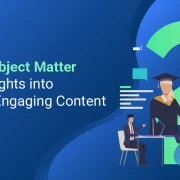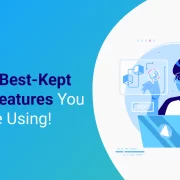
The Future of WAI-ARIA Authoring Practices: Emerging Trends and Innovations
The online space is becoming increasingly sophisticated, showing why WAI-ARIA authoring practices are so important for increasing web accessibility, regardless of disability.
Over 98% of the world’s websites are not accessible enough, as they don’t follow the Web Content Accessibility Guidelines (WCAG), which hinders individuals with a disability from browsing through a significant chunk of online content.
WAI-ARIA authoring principles offer guidelines and techniques for website developers to adopt accessibility. These principles prefer ARIA attributes and HTML markup, which empower all kinds of users to interpret web content effectively.
This helps users with visual impairments, mobility difficulties, or other disabilities interact with websites and applications. In this guide, we will learn about WAI-ARIA authoring practices and how emerging trends are revolutionizing web accessibility.
Table of Contents:
- What are WAI-ARIA Authoring Practices?
- WAI-ARIA Authoring Principles
- WAI-ARIA and Accessibility Standards
- New Trends in WAI-ARIA Authoring Practices
- Conclusion
What are WAI-ARIA Authoring Practices?
WAI-ARIA Authoring practices include designing, creating, developing, securing, and coding web content and applications. This process follows the guidelines of the Web Accessibility Initiative – Accessible Rich Internet Applications.
This process ensures that web content is accessible to users who depend on assistive technologies. For example, people with disabilities can use screen readers, which means the content should be framed in a way that is accessible to them.
Here are its key features:
- WAI or Web Accessibility Initiative: It is a part of the World Wide Web Consortium that focuses on making its web content and technologies accessible to everyone.
- Accessible Rich Internet Applications (ARIA): These are technical specifications that help make web content and custom user interface elements accessible.
- Authoring: This is the application of specifications in developing web applications along with their content. Best practices are used here to make interactive and dynamic web features accessible.
Purpose of WAI-ARIA Authoring Practices
Authoring WAI-ARIA guarantees:
- Interaction between screen readers, voice input programs, and other assistive devices with the help of web content.
- Comprehension of difficult web content.
- Empowerment of the ability of people with disabilities to access web software without help.
In simple words, WAI-ARIA authoring is a way of making modern, interactive web applications accessible to all.
Also Read: Navigating Accessibility Standards: A Comprehensive Guide to WCAG & Web Content Accessibility
WAI-ARIA Authoring Principles
Here are some key principles that can help enhance the accessibility of web content:
1. ARIA Landmarks
ARIA landmarks help in organizing web pages. They present clear navigation paths through header and footer items, navigation menus, and central content blocks. Adding these landmarks improves the development experience, from keyboard navigation to specific structural information for assistive technologies.
2. Keyboard Navigation
Accessibility to the keyboard is non-negotiable for users with motor impairments and those who cannot use a mouse. WAI-ARIA best practices promote making all interactive elements accessible with keyboard commands. This includes the use of:
- Tab to navigate between focusable elements
- Arrow keys for inland navigation, such as inside a component, for example, menus
- Enter/Space to activate button or link
3. Assistive Technologies
WAI-ARIA practices ensure that the developed application remains compatible with assistive technologies such as screen readers and text-to-speech tools. The developers provide all the appropriate cues for these technologies to convey content appropriately, enabling accessibility.
4. Web Forms
Web forms help in user interaction. WAI-ARIA practices emphasize the importance of web forms with clear labels, detailed instructions, clear fonts, and intuitive error handling. This is to ensure that such forms are usable by everyone, irrespective of their ability.
5. Mobile Accessibility
Today, mobile applications are dominating digital interactions. ARIA implementation helps in optimizing accessibility for all kinds of screens, even mobile screens. Developers are asked to use bigger touch targets, alternative text for images, and compatibility with mobile assistive technologies while building accessible mobile experiences.
6. Native HTML Elements
HTML5 elements are more accessible and, therefore, should be used instead of custom widgets. Natively supported elements receive automatic support from browsers and assistive technologies effortlessly.
7. Other Best Practices
Some of the other best WAI-ARIA authoring practices include:
- ARIA states such as ARIA-checked or ARIA-disabled are used in case of updating the state of an element.
- Avoid overusing ARIA; it must be used at the point of need. Overloading with ARIA attributes creates confusion and reduces accessibility.
- Test your application using a screen reader and keyboard control. This will help you find usability issues for a user dependent on assistive technologies.
Also Read: How to Enhance User Experience for Web Accessibility Testing?
WAI-ARIA and Accessibility Standards
WAI-ARIA principles are based on the Web Content Accessibility Guidelines. Such guidelines offer a structured framework that promotes and ensures accessibility compliance. Adhering to these standards helps organizations comply with legal requirements and make sure that inclusivity and equal access to digital services are committed. It includes:
1. Inclusive Design and Enhanced User Experience
Inclusive design is the core of accessible web development. WAI-ARIA practices promote the creation of interfaces according to the individual needs of all users. This ensures that digital products are intuitive, engaging, understandable, and accessible to everyone. It makes digital content usable and inclusive.
2. Digital Accessibility Compliance
Being digitally accessible means complying with legal requirements and fulfilling a deep ethical commitment toward inclusivity and equity. Organizations must ensure that digital platforms, websites, and apps are accessible to a broad spectrum of the population with disabilities.
WAI-ARIA authoring practices are essential to meeting this accessibility. These principles empower designers and developers with strategies, tools, best practices, and techniques for creating digital experiences that include everyone.
Adhering to accessibility compliance means creating an environment where everyone can engage and interact. Everyone should be able to benefit from digital content and services. Businesses that support digital accessibility are champions of inclusivity, trust, loyalty, and respect among audiences.
New Trends in WAI-ARIA Authoring Practices
The future of WAI-ARIA revolves around the advances in technology. Innovations in AI-powered accessibility tools lead to a more inclusive digital ecosystem. Such an approach makes the Web more interactive for everyone.
Here are the key technology-related trends that influence WAI-ARIA authoring practices:
- AI-powered accessibility tools
- Automated accessibility testing
- Improved collaboration frameworks
- Dynamic ARIA roles and attributes
- Mobile accessibility optimization
- Accessibility APIs
- Integration with Inclusive Design Principles
- Machine learning for usability insights
- Focus on real-time content updates
- Support for virtual and augmented reality
Also Read: A Comprehensive Guide on the Top AI-powered eLearning Authoring Tools.
Conclusion
WAI-ARIA authoring best practices hold a promising future for web accessibility. Developers can now build accessible digital experiences by specifying ARIA landmarks and facilitating compatibility with assistive technologies. WCAG guidelines on digital ethics include inclusive design, which leads to an accessible digital world.
If you are looking for the best platforms for accessibility compliance, collaborate with experts like Hurix Digital to become a champion of digital inclusivity.
We are ready to help you learn about WAI-ARIA authoring practices and move along with the accessible digital landscape.

Vice President – Digital Content Transformation. He is PMP, CSM, and CPACC certified and has 20+ years of experience in Project Management, Delivery Management, and managing the Offshore Development Centre (ODC).




